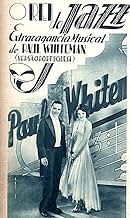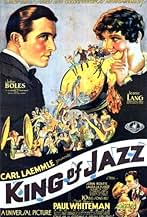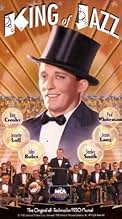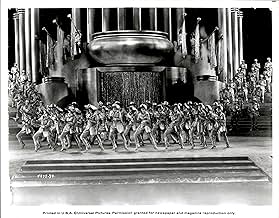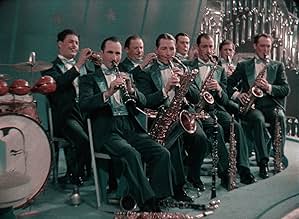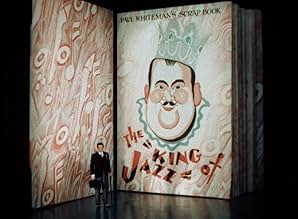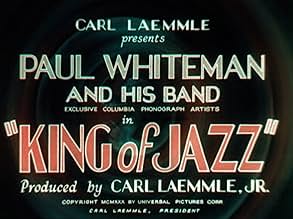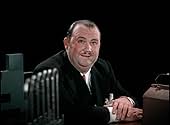VALUTAZIONE IMDb
6,7/10
1717
LA TUA VALUTAZIONE
Aggiungi una trama nella tua linguaA rotund bandleader leads a series of theatrical sketches, dance numbers, special effects, and animated segments.A rotund bandleader leads a series of theatrical sketches, dance numbers, special effects, and animated segments.A rotund bandleader leads a series of theatrical sketches, dance numbers, special effects, and animated segments.
- Vincitore di 1 Oscar
- 2 vittorie totali
Harry Barris
- One of the Rhythm Boys
- (as The Rhythm Boys)
Bing Crosby
- One of the Rhythm Boys
- (as The Rhythm Boys)
Al Rinker
- One of the Rhythm Boys
- (as The Rhythm Boys)
Carla Laemmle
- Chorine
- (as Beth Laemmle)
Trama
Lo sapevi?
- QuizThe animation sequence, created by Walter Lantz, was the first Technicolor animation ever produced.
- BlooperWhiteman's six violinists are introduced playing in two rows of 3's. Then without missing a beat, they are suddenly seen in an overhead shot playing in a circle.
- Citazioni
Announcer: You don't mean to tell me that you are well-versed in the intricacies of the art of Terpsichore?
Paul Whiteman: No, but I can dance.
- Versioni alternativeRestored in 2016 with a running time of 99 minutes. This version replicates the scene continuity of the 1930 release version, including about a minute of exit music. A small amount of footage was not found and is covered by still photographs. This is the version that played at the Museum of Modern Art and Film Forum in 2016, and was released by the Criterion Collection on Blu-ray and DVD in 2018.
- ConnessioniFeatured in The All Talking, All Singing, All Dancing Show (1973)
- Colonne sonoreRhapsody in Blue
(uncredited)
Music by George Gershwin
Played briefly during the opening credits
Played by Paul Whiteman and Orchestra (as "The Paul Whiteman Orchestra") during the production number
Performed by Roy Bargy (piano)
Danced by Jacques Cartier with clarinet, along with the Russell Markert Girls and The Sisters G
Recensione in evidenza
Today's audiences could not possibly have any idea of how big in every way Paul Whiteman was during the 1920s. Radio was in its infancy and Paul Whiteman's band was the first orchestra to achieve popularity through that medium. Whiteman records were the biggest sellers of their time. And The King of Jazz was his auspicious debut in motion pictures.
The King of Jazz was also how Whiteman billed himself. He was maybe taking a bit much on to himself with that one, he surely didn't have anything to do with the development of jazz as an art form. But he did help a great deal to popularize it with a wider {white} audience. That was primarily done with that famous jazz concert that Whiteman gave in the mid twenties where George Gershwin's Rhapsody In Blue made its debut. And Rhapsody is reprised here in the movie.
Whiteman's greatest contribution may have been the training of the greatest group of musicians ever. At one time or other, the Dorsey Brothers, Benny Goodman, Bix Biederbecke and so many others were members of the Whiteman orchestra. And of course he was the very first band to hire a vocalist specifically for that role. Previously singers were just musicians who just stopped playing and sang a chorus or two.
Whiteman hired a trio, the Rhythm Boys whose lead singer was Bing Crosby. They are prominent in the film and in fact Bing Crosby made his singing film debut here over the opening credits as he sang Music Hath Charms. He was Whiteman's biggest discovery.
The film is just a musical review done in the style of some of the great musical reviews of the time like the Ziegfeld Follies, Earl Carroll's Vanities, George White's Scandals. Some of the acts are better than others, but's The King of Jazz encapsulates a great era in show business.
The biggest song from the film was It Happened in Monterey sung by John Boles who was Universal's biggest musical star at that point. Boles also got to do the film's finale, The Song of the Dawn, when Crosby who was guzzling a little too much bathtub gin got himself arrested and missed doing the finale which he was scheduled for.
Shortly after recording some of the songs from The King of Jazz the Rhythm Boys left Whiteman and broke up soon after that. Bing Crosby would be heard from again.
For a wonderful piece of nostalgia and filmed in early technicolor at that as an added treat, you can't beat The King of Jazz.
The King of Jazz was also how Whiteman billed himself. He was maybe taking a bit much on to himself with that one, he surely didn't have anything to do with the development of jazz as an art form. But he did help a great deal to popularize it with a wider {white} audience. That was primarily done with that famous jazz concert that Whiteman gave in the mid twenties where George Gershwin's Rhapsody In Blue made its debut. And Rhapsody is reprised here in the movie.
Whiteman's greatest contribution may have been the training of the greatest group of musicians ever. At one time or other, the Dorsey Brothers, Benny Goodman, Bix Biederbecke and so many others were members of the Whiteman orchestra. And of course he was the very first band to hire a vocalist specifically for that role. Previously singers were just musicians who just stopped playing and sang a chorus or two.
Whiteman hired a trio, the Rhythm Boys whose lead singer was Bing Crosby. They are prominent in the film and in fact Bing Crosby made his singing film debut here over the opening credits as he sang Music Hath Charms. He was Whiteman's biggest discovery.
The film is just a musical review done in the style of some of the great musical reviews of the time like the Ziegfeld Follies, Earl Carroll's Vanities, George White's Scandals. Some of the acts are better than others, but's The King of Jazz encapsulates a great era in show business.
The biggest song from the film was It Happened in Monterey sung by John Boles who was Universal's biggest musical star at that point. Boles also got to do the film's finale, The Song of the Dawn, when Crosby who was guzzling a little too much bathtub gin got himself arrested and missed doing the finale which he was scheduled for.
Shortly after recording some of the songs from The King of Jazz the Rhythm Boys left Whiteman and broke up soon after that. Bing Crosby would be heard from again.
For a wonderful piece of nostalgia and filmed in early technicolor at that as an added treat, you can't beat The King of Jazz.
- bkoganbing
- 7 giu 2005
- Permalink
I più visti
Accedi per valutare e creare un elenco di titoli salvati per ottenere consigli personalizzati
- How long is King of Jazz?Powered by Alexa
Dettagli
- Data di uscita
- Paese di origine
- Lingue
- Celebre anche come
- King of Jazz
- Luoghi delle riprese
- Azienda produttrice
- Vedi altri crediti dell’azienda su IMDbPro
Botteghino
- Budget
- 2.000.000 USD (previsto)
- Tempo di esecuzione1 ora 39 minuti
Contribuisci a questa pagina
Suggerisci una modifica o aggiungi i contenuti mancanti


